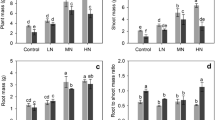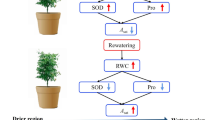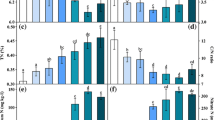Abstract
Sites in need of restoration typically have one or more environmental factors that limit seedling establishment. Identifying ecophysiological responses to environmental stressors can provide important insights into mitigating measures that would allow seedlings to overcome such constraints to survival. Koa (Acacia koa A. Gray) is a nitrogen-fixing tree species endemic to Hawaiʻi that is highly valued in restoring degraded forest ecosystems, which are often limited in available water and phosphorus. This study examined how koa seedlings respond to conditions of reduced water (65 W) and no phosphorus (0P). After 17 weeks, seedlings subjected to 65 W or 0P accumulated less biomass, smaller root-collar diameters, and lower nitrogen and phosphorus contents. Combined reductions in water and P resulted in seedlings with increased root to shoot dry biomass and shorter shoots. Seedlings subjected to 65 W also had lower instantaneous rates of CO2 assimilation, but higher instantaneous water-use efficiencies following irrigation, suggesting that koa responds to water deficits by decreasing water loss via reduced stomatal conductance. Seedlings subjected to 0P had similar rates of CO2 assimilation relative to those grown with adequate P, suggesting that koa is able to employ strategies to avoid physiological impairment from conditions of inadequate P. Future research should assess whether subjecting koa seedlings to reduced water before planting on water-limited sites cues increased drought resistance and whether uptake and storage of P by seedlings in the nursery better supports growth following outplanting, particularly on sites with anticipated low plant-available water.



Similar content being viewed by others
References
Ahanger MA, Morad-Talab N, Abd-Allah EF, Ahmad P, Hajiboland R (2016) Chapter 37: Plant growth under drought stress: significance of mineral nutrients. In: Ahmad P (ed) Water stress and crop plants: a sustainable approach, pp 649–668
Alsina MM, Smart DR, Bauerle T, de Herralde F, Biel C, Stockert C, Negron C, Save R (2011) Seasonal changes of whole root system conductance by a drought-tolerant grape root system. J Exp Bot 62(1):99–109. https://doi.org/10.1093/jxb/erq247
Ares A, Fownes JH (1999) Water supply regulates structure, productivity, and water use efficiency of Acacia koa forest in Hawaii. Oecologia 121(4):458–466
Ares A, Fownes JH, Sun W (2000) Genetic differentiation of intrinsic water-use efficiency in the Hawaiian native Acacia koa. Int J Plant Sci 161(6):909–915
Baker PJ, Scowcroft PG, Ewel JJ (2009) Koa (Acacia koa) Ecology and Silviculture. Gen. Tech. Rep. PSW-GTR-211. U.S. Department of Agriculture, Forest Service, Pacific Southwest Research Station, Albany, CA.
Canadell J, Jackson RB, Ehleringer JR, Mooney HA, Sala OE, Schulze ED (1996) Maximum rooting depth of vegetation types at the global scale. Oecologia 108:583–595
Chapin FS III (1991) Integrated responses of plants to stress. Bioscience 41:29–36
Chapin FS III, Autumn K, Pugnaire F (1993) Evolution of suites of traits in response to environmental stress. Am Nat 142:S78–S92
Chavasse CGR (1977) The significance of planting height as an indicator of subsequent seedling growth. N Z J for 22:283–296
Chaves MM, Maroco JP, Pereira JS (2003) Understanding plant response to drought-from genes to the whole plant. Funct Plant Biol 30:239–264
Cole TG, Yost RS, Kablan RB, Olsen T (1996) Growth potential of twelve Acacia species on acid soils in Hawaii. For Ecol Manag 80:175–186
Cregg BM (1994) Carbon allocation, gas exchange, and needle morphology of Pinus ponderosa genotypes known to differ in growth and survival under imposed drought. Tree Physiol 14:883–898
Cuddihy LW, Stone CP (1990) Alteration of native Hawaiian vegetation: effects of humans, their activities and introductions. Cooperative National Parks Studies Unit, University of Hawaii at Manoa, Honolulu
Dalling JW, Heineman K, Lopez OR, Wright SJ, Turner BL (2016) Nutrient availability in tropical rain forests: the paradigm of phosphorus limitation. Trop Tree Physiol 6:261–273. https://doi.org/10.1007/978-3-319-27422-5_12
Deenik J, McClellan AT (2007) Soils of Hawaii. University of Hawaii at Manoa, Honolulu
Denslow JS, Uowolo AL, Hughes RF (2006) Limitations to seedling establishment in a mesic Hawaiian forest. Oecologia 148:118–128. https://doi.org/10.1007/s00442-005-0342-7
Dudley NS, Jones T, James R, Sniezko R, Wright J, Liang C, Cannon P (2017) Applied genetic conservation of Hawaiian Acacia koa: an eco-regional approach. In: Sniezko RA, Man G,Hipkins V, Woeste K, Gwaze D, Kliejunas JT, McTeague BA (tech cords) Gene conservation of tree species—banking on the future. Proceedings of a workshop. Gen. Tech. Rep. PNW-GTR-963. Portland, OR: U.S. Department of Agriculture, Forest Service, Pacific Northwest Research Station, pp 78–91
Dumroese RK (2012) Integrated nursery pest management. In: Cram MM, Frank MS, Mallams KM, technical coordinators. Forest Nursery Pests. Washington, DC: USDA Forest Service, Agriculture Handbook 680: 5–12
Dumroese KD, Page-Dumroese DS, Salifu KF, Jacobs DF (2005) Exponential fertilization of Pinus monticola seedlings: nutrient uptake efficiency, leaching fractions, and early outplanting performance. Can J For Res 35:2961–2967
Dumroese RK, Davis AS, Jacobs DF (2011) Nursery response of Acacia koa seedlings to container size, irrigation method, and fertilization rate. J Plant Nutr 34(6):877–887
Dumroese RK, Montville ME, Pinto JR (2015) Using container weights to determine irrigation needs: a simple method. Native Plants J 16(1):67–71
Dumroese RK, Landis TD, Pinto JR, Haase DL, Wilkinson KW, Davis AS (2016) Meeting forest restoration challenges: Using the target plant concept. Reforesta 1:37–52
Duryea ML (1984) Nursery cultural practices: impacts on seedling quality. In: Duryea ML, Landis TD (eds) Forest nursery manual: production of bareroot seedlings. Martinus Nijhoff/Dr. W. Junk Publishers, The Hague, pp 143–164
Elevitch CR, Abbott IA, Leakey RRB (2006) Traditional trees of Pacific Islands: Their culture, environment, and use. Hōlualoa, Hawaiʻi: Permanent Agriculture Resources, p 861
Ellsworth DS, Crous KY, Lambers H, Cooke J (2015) Phosphorus recycling in photorespiration maintains high photosynthetic capacity in woody species. Plant Cell Environ 38:1142–1156. https://doi.org/10.1111/pce.12468
Fang S, Yan X, Liao H (2009) 3D reconstruction and dynamic modeling of root architecture in situ and its application to crop phosphorus research. Plant J 60:1096–1108. https://doi.org/10.1111/j.1365-313X.2009.04009
Friday JB (2011) Farm and forestry production and marketing profile for Koa (Acacia koa). In: Elevitch CR (ed) Specialty Crops for Pacific Island Agroforestry, Permanent Agriculture Resources Holualoa, Hawai‘i.
Giambelluca TW, Chen Q, Frazier AG, Price JP, Chen Y, Chu P, Eischeid JK, Delparte DM (2013) Online rainfall atlas of Hawai‘i. Bull Am Meteorol Soc 94(3):313–316. https://doi.org/10.1175/BAMS-D-11-00228.1
Grossnickle SC (2005) Importance of root growth in overcoming plant stress. New for 30:273–294. https://doi.org/10.1007/s11056-004-8303-2
Grossnickle SC (2012) Why seedlings survive: influence of plant attributes. New for 43:711–738. https://doi.org/10.1007/s11056-012-9336-6
Harrington RA, Fownes FJ, Meinzer FC, Scowcroft PG (1995) Forest growth along a rainfall gradient in Hawaii: Acacia koa stand structure, productivity, foliar nutrients, and water- and nutrient-use efficiencies. Oecologia 102(3):277–284
He M, Dijkstra FA (2014) Drought effect on plant nitrogen and phosphorus: a meta- analysis. New Phytol 204:924–931. https://doi.org/10.1111/nph.12952
Heitholt JJ, Johnson RC, Ferris DM (1991) Stomatal limitation to carbon dioxide assimilation in nitrogen and drought-stressed wheat. Crop Sci 31:135–139
Hetherington AM (1998) Plant physiology: spreading a drought warning. Curr Biol 8(25):R911–R913
Hiradate S, Uchida N (2004) Effects of soil organic matter on pH-dependent phosphate sorption by soils. Soil Sci Plant Nutr 50(5):665–675. https://doi.org/10.1080/00380768.2004.10408523
Ho MD, McCannon BC, Lynch JP (2004) Optimization modeling of plant root architecture for water and phosphorus acquisition. J Theor Biol 226:331–340
Jacobs DF, Davis AS, Dumroese RK, Burney OT (2020) Nursery cultural techniques facilitate restoration of Acacia koa competing with invasive grass in a dry tropical forest. Forests 11(11):1124. https://doi.org/10.3390/f11111124
Karthika KS, Rashmi I, Parvathi MS (2018) Biological functions, uptake and transport of essential nutrients in relation to plant growth. In: Plant nutrients and abiotic stress tolerance. Springer, Singapore, pp 1–49
Kolb TE, Steiner KC, McCormick LH, Bowersox TW (1990) Growth response of northern red-oak and yellow-poplar seedlings to light, soil moisture, and nutrients in relation to ecological strategy. For Ecol Manag 38:65–78
Kuwahara FA, Souza GM, Guidorizi KA, Costa C, Meirelles PRDL (2016) Phosphorus as a mitigator of the effects of water stress on the growth and photosynthetic capacity of tropical C4 grasses. Acta Sci Agron 38(3):363–370. https://doi.org/10.4025/actasciagron.v38i3.28454
Lambers H, Cawthray GR, Giavalisco P, Kuo J, Laliberté E, Pearse SJ, Scheible WR, Stitt M, Teste F, Turner BL (2012) Proteaceae from severely phosphorus-impoverished soils extensively replace phospho-lipids with galactolipids and sulfolipids during leaf development to achieve a high photosynthetic phosphorus-use-efficiency. New Phytol 196:1098–1108
Landis TD, Dumroese, RK (2006) Applying the Target Plant Concept to nursery stock quality. In: MacLennan L, Fennessy J (eds), Plant quality: a key to success in forest establishment, proceedings of the COFORD conference, National Council for Forest Research and Development, Dublin, Ireland, pp 1–10
Leary JJK, Singleton PW, Borthakur D (2004) Canopy nodulation of the endemic tree legume Acacia koa in the mesic forests of Hawaii. Ecology 85(11):3151–3157
Lui C, Wang Y, Jin Y, Pan K, Zhou X, Li N (2017) Photoprotection regulated by phosphorus application can improve photosynthetic performance and alleviate oxidative damage in dwarf bamboo subjected to water stress. Plant Physiol Bioch 118:88–97
Lynch J (1995) Root architecture and plant productivity. Plant Physiol 109:7–13
McTague JP, Tinus RW (1996) The effects of seedling quality and forest site weather on field survival of ponderosa pine. Tree Planters’ Notes 47:16–32
Mexal JG, Landis TD (1990) Target seedling concepts: height and diameter. In: Rose R, Campbell SJ, Landis TD (eds) Target seedling symposium: proceedings of the western forest nursery associations, USDA Forest Service Gen Tech Rep RM-200, pp 17–36
Miyasaka SC, Habte M, Matsuyama DT (1993) Mycorrhizal dependency of two Hawaiian endemic tree species: Koa and mamane. J Plant Nutr 16(7):1339–1356
Oliet JA, Planelles R, Artero F, Jacobs D (2005) Nursery fertilization and tree shelters affect long-term field response of Acacia salicina Lindl. planted in Mediterranean semiarid conditions. For Ecol Manag 215(1–3):339–351
Oliet JA, Puertolas J, Planelles R, Jacobs DF (2013) Nutrient loading of forest tree seedlings to promote stress resistance and field performance: a Mediterranean perspective. New for 44:649–669. https://doi.org/10.1007/s11056-013-9382-8
Pasquet-Kok J, Creese C, Sack L (2010) Turning over a new “leaf”: multiple functional significances of leaves versus phyllodes in Hawaiian Acacia koa. Plant Cell Environ 33(12):2084–2100. https://doi.org/10.1111/j.1365-3040.2010.02207.x
Pearson HL, Vitousek PM (2001) Stand dynamics, nitrogen accumulation, and symbiotic nitrogen fixation in regenerating stands of Acacia koa. Ecol Appl 11(5):1381–1394
Pearson HL, Vitousek PM (2002) Soil phosphorus fractions and symbiotic nitrogen fixation across a substrate-age gradient in Hawaii. Ecosystems 5:587–596. https://doi.org/10.1007/s10021-002-0172-y
Pejchar L, Holl KD, Lockwood JL (2005) Hawaiian Honeycreeper home range size varies with habitat: implications for native Acacia koa forestry. Ecol Appl 15(3):1053–1061
Pinto J, Davis AS, Leary JJK, Aghai MM (2015) Stocktype and grass suppression accelerate the restoration trajectory of Acacia koa in Hawaiian montane ecosystems. New for 46:855–867
Poorter H, Niklas KJ, Reich PB, Oleksyn J, Poot P, Mommer L (2012) Biomass allocation to leaves, stems and roots: meta-analyses of interspecific variation and environmental control. New Phytol 193(1):30–50
Ritchie G Landis TD (2005) Seedling quality tests: plant moisture stress. In: Dumroese, R. Kasten; Landis, Tom D.; Watson, Rae. Forest Nursery Notes. R6-CP-TP-06-2005. Portland, OR: USDA Forest Service, Pacific Northwest Region, State and Private Forestry, Cooperative Programs, pp 6–12
Rose KME, Baribault TW, Jacobs DF (2016) Alternative field fertilization techniques to promote restoration of leguminous Acacia koa on contrasting tropical sites. For Ecol Manag 376:126–134. https://doi.org/10.1016/j.foreco.2016.06.012
Rose KME, Mickelbart MV, Jacobs DF (2019) Plasticity of phenotype and heteroblasty in contrasting populations of Acacia koa. Ann Bot 124(3):399–409
Royo A, Gil L, Pardos JA (2001) Effect of water stress conditioning on morphology, physiology and field performance of Pinus halepensis Mill. seedlings. New for 21(2):127–140
Schindelin J, Arganda-Carreras I, Frise E, Kaynig V, Longair M, Pietzsch T, Preibisch S, Rueden C, Saalfeld S, Schmid B, Tinevez J, White DJ, Hartenstein V, Eliceiri K, Tomancak P, Cardona A (2012) Fiji: an open-source platform for biological-image analysis. Nat Methods 9(7):676–682. https://doi.org/10.1038/nmeth.2019
Scowcroft PG, Silva JA (2005) Effects of phosphorus fertilization, seed source, and soil type on growth of Acacia koa. J Plant Nutr 28:1581–1603
Scowcroft PG, Friday JB, Idol T, Dudley N, Haraguchi J, Meason D (2007) Growth response of Acacia koa trees to thinning, grass control, and phosphorus fertilization in a secondary forest in Hawai‘i. For Ecol Manag 239:69–80. https://doi.org/10.1016/j.foreco.2006.11.009
Seiler JR, Johnson JD (1988) Physiological and morphological responses of three half-sib families of loblolly pine to water-stress conditioning. For Sci 34(2):487–495
Sloan JL, Burney OT, Pinto JR (2020) Drought-conditioning of quaking aspen (Populus tremuloides Michx.) seedlings during nursery production modifies seedling anatomy and physiology. Front Plant Sci 11:1325
Spatz G, Mueller-Dombois D (1973) The influence of feral goats on Koa tree reproduction in Hawaii Volcanoes National Park. Ecology 54(4):870–876
Sulpice R, Ishihara H, Schlereth A, Cawthray GR, Encke B, Giavalisco P, Ivakov A, Arrivault S, Jost R, Krohn N, Kuo J, Laliberte E, Pearse SJ, Raven JA, Scheible WR, Teste F, Vaneklaas EJ, Stitt M, Lambers H (2014) Low levels of ribosomal RNA partly account for the very high photosynthetic phosphorus-use efficiency of Proteaceae species. Plant Cell Environ 37:1276–1298. https://doi.org/10.1111/pce.12240
Tariq A, Pan K, Olatunji OA, Graciano C, Li Z, Sun F, Sun X, Song D, Chen W, Zhang A, Wu X, Zhang L, Mingrui D, Xiong Q, Liu C (2017) Phosphorous application improves drought tolerance of Phoebe zhennan. Front Plant Sci 8:1561. https://doi.org/10.3389/fpls.2017.01561
Thompson BE (1986) Seedling morphological evaluation: what you can tell by looking. In: Duryea ML (ed) Evaluating seedling quality: principles, procedures, and predictive abilities of major tests. Oregon State University, Corvallis, pp 59–71
Tuttle CL, South DB, Golden MS, Meldahl RS (1987) Relationship between initial seedling height and survival and growth of loblolly pine seedlings planted during a droughty year. South J Appl for 11(3):139–143
Villar-Salvador P, Ocaña L, Peñuelas J, Carrasco I (1999) Effect of water stress conditioning on the water relations, root growth capacity, and the nitrogen and non-structural carbohydrate concentration of Pinus halepensis Mill. (Aleppo pine) seedlings. Ann for Sci 56:459–465. https://doi.org/10.1051/forest:19990602
Villar-Salvador P, Puertolas J, Cuesta B, Penuelas JL, Uscola M, Heredia-Guerrero N, Rey-Benayas JM (2012) Increase in size and nitrogen concentration enhances seedling survival in Mediterranean plantations. Insights from an ecophysiological conceptual model of plant survival. New for 43:755–770
Vitousek PM, Chadwick OA (2013) Pedogenic thresholds and soil process domains in basalt-derived soils. Ecosystems 16(8):1379–1395
Waraich EA, Ahmad R, Ashraf MY (2011) Role of mineral nutrition in alleviation of drought stress in plants. Aust J Crop Sci 5(6):764–777
Wilkinson KM, Elevitch CR (2003) Growing Koa: A Hawaiian Legacy Tree. Permanent Agriculture Resources, Holualoa
Acknowledgements
The authors wish to thank Carson Alberg for his assistance in experiment establishment and data collection and Nicklos Dudley for providing seeds, and Chris Catricala for assistance with tissue nutrient analyses.
Funding
This work was supported by the College of Forestry at Oregon State University (Corvallis, OR, USA). Funding was provided by the Oxbow Farm and Conservation Center.
Author information
Authors and Affiliations
Contributions
Conceptualization: KG and AD; Methodology: KG and AD; Formal analysis and investigation: KG, AD, and AR-D; Writing—original draft preparation: KG and AD; Writing—review and editing: KG, AD, AR-D, and SP; Funding acquisition: KG and AD; Resources: AD, SP; Supervision: AD and SP.
Corresponding author
Ethics declarations
Conflict of interest
The authors have no conflicts of interest to declare that are relevant to the content of this article. The datasets generated and analyzed during the current study, as well as the codes used for analysis, are available from the corresponding author on reasonable request. Any use of trade, firm, or product names is for descriptive purposes only and does not imply endorsement by the U.S. Government.
Additional information
Publisher's Note
Springer Nature remains neutral with regard to jurisdictional claims in published maps and institutional affiliations.
Rights and permissions
About this article
Cite this article
Gerber, K., Ross-Davis, A., Perakis, S.S. et al. Early growth and ecophysiological responses of Koa (Acacia koa A. Gray) seedlings to reduced water and phosphorus. New Forests 53, 643–660 (2022). https://doi.org/10.1007/s11056-021-09877-8
Received:
Accepted:
Published:
Issue Date:
DOI: https://doi.org/10.1007/s11056-021-09877-8




